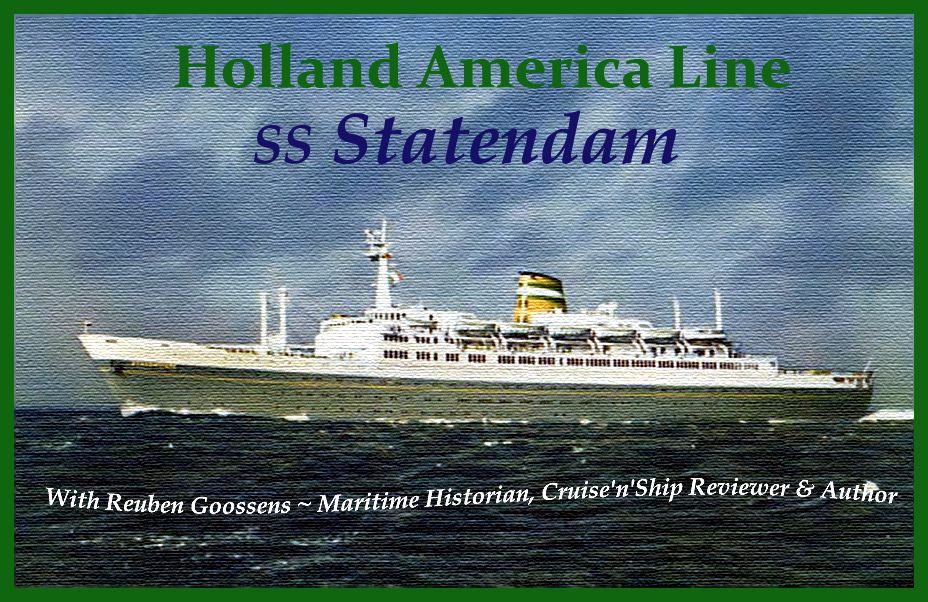World
War Two came to a conclusion it was time to start
rebuilding the city of Rotterdam that
had its entire heart destroyed, as well as other cities and villages throughout
the Netherlands.
However there were also many ships sunk during this terrible war on all sides
and from so many countries as well some fine Dutch liners, thus an extensive
rebuilding programme of ships and liners would play a huge part in reviving the
Dutch financial situation as it would all over Europe and Great Britain, for
let’s face it, shipping was the main means of transport of passengers and
cargoes across the oceans! But the new ships were being designed by the finest
maritime architects they were well aware that these ships would have to be by
far superior and offer new and advanced technologies and superior facilities
than ever before than their pre-war counterparts.
One of the first things that Holland America
Line (HAL) had to do after the war was to have their finest liner refitted
after having served as a Troopship throughout the war under the British
Ministry of Transport, and in October 1947 she returned to service, and she is
still famed to this day as the most beautiful ship ever designed and built!
However, this famed grand old and established Trans-Atlantic companies decided
very early on that they were going to head in a new direction and base their new
build’s more on a Tourist Class “run of the ship” effect,
meaning that Promenade Deck would be wholly devoted to this class forward to
aft, and that this new style of class should be by far a superior one. In 1950
two ships were commenced as cargo ships, but whilst being built HAL decided to
finish them as two fine passenger liners and named them SS Ryndam (1951) and
Maasdam (1952). At 15,000-tons they accommodated 822 Tourist Class passengers
and an intimate section for just 39 First Class up on Boat Deck. With
affordable prices, these two ships became very popular and profitable indeed.
HAL marked them as “The Economy Twins.”
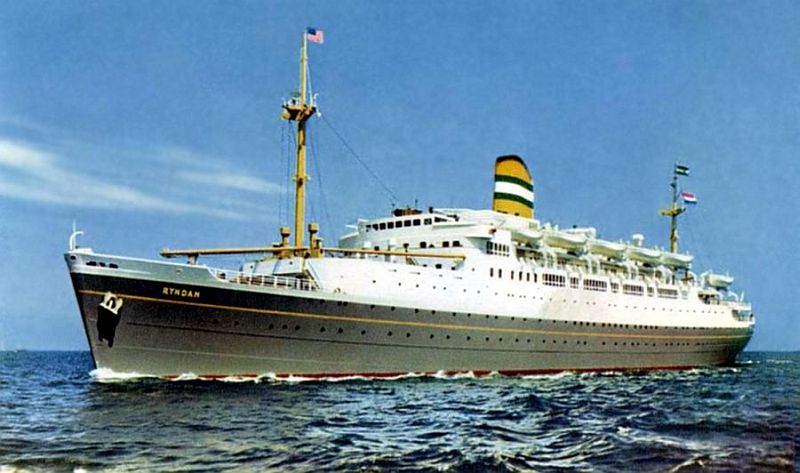
A postcard
of the SS
Ryndam
Considering
the huge success of the sisters, the SS Ryndam and Maasdam HAL
decided that they would continue the Tourist Class “run of the
ship” idea with their next but much larger liner, which would become
known as the SS Statendam, the
fourth liner bearing this distinguished name.
The first three SS
Statendam’s:
The
10,491 ton SS
Statendam
(1) was built in 1898 by Harland & Wolff, Belfast
and sold to Allan Line Steamship Company Ltd, Glasgow in 1911. She was scrapped at Genoa
in 1927.
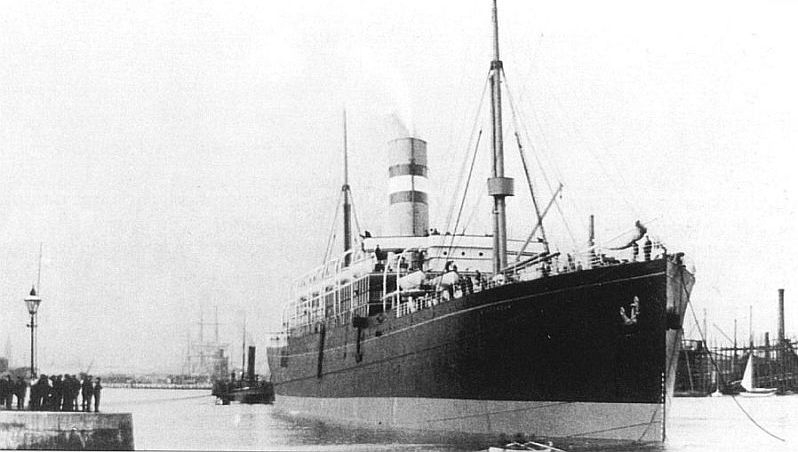
SS Statendam I - 1898
The
32.234 ton SS
Statendam
(2) was built in 1917 by Harland & Wolff, Belfast.
She never sailed for HAL as she was requisitioned by the British government.
Torpedoed and sank in 1918 named SS.
Justicia.
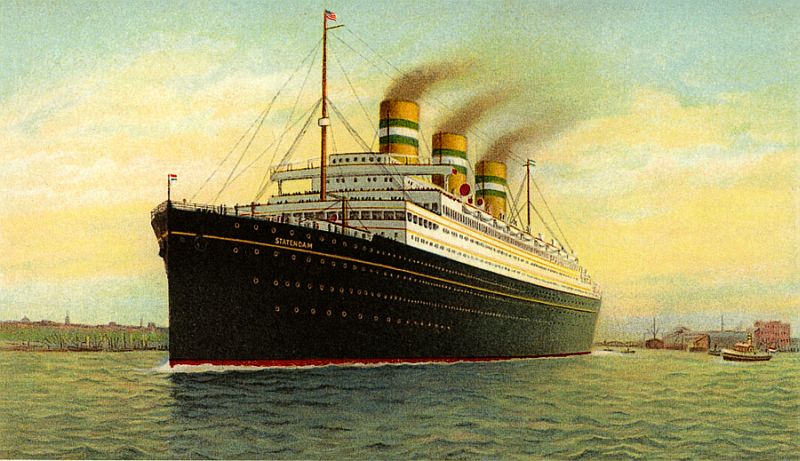
Painting
of the SS
Statendam II
- 1917
The
29.511 ton SS Statendam (3) 1929 - 1940 * Built by Harland & Wolff, Belfast
in 1921, but completed in 1929. She burnt out in May 1940 and scrapped in
August 1940.
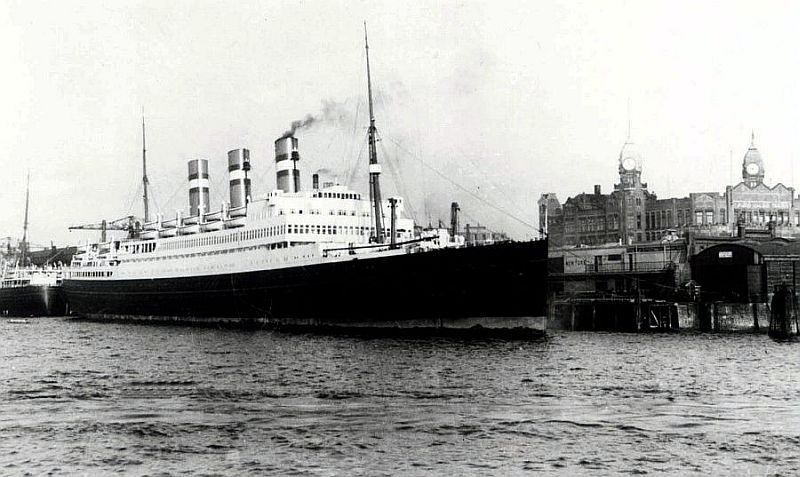
SS Statendam III - 1940
Planning
SS Statendam (4) -
Ship 753:
Her
planning had commenced in 1953, but was taking good shape in 1954. Many new
improvements were incorporated into her design compared to the earlier sisters
for this new, as yet unnamed ship, was just known as number 753 was built as a
passenger liner from the laying of her building plate. In addition, she would
be almost 10,000 tons larger than the aforementioned
ships and this extra size would allow a far superior hull design as the
previous ships did have hulls that were essentially designed for their original
role as passenger cargo ships. The 753 would be fitted with twin screws, thus
her service speed would be a good 19 knots compared to the 16 knots “The
Economy Twins.” However, the Tourist Class flow throughout the ship would
once again be first and foremost, but this time of a much higher standard
utilising some of the finest artisans that HAL could gather.
With the overall plan agreed upon, HAL signed
a building contract with the Wilton-Fijenoord shipyards at Schiedam
and had the blueprints completed and approved, after which the actual
construction could commence. Unlike most liners she would not be built on a
slipway, but very similar to the great SS United States in 1951, she was constructed within a dry dock.
This caused a great deal of publicity at the time, but the truth is that HAL
was far ahead of their times for these days this kind of construction is very
much the norm when they build the largest of ships, but now ships are no longer
built as one whole but in pre fabricated sections and then welded together
until it become a whole.
Building the 753:
As
time passed an attractive new modern looking ship had taken shape and on June
12, 1956, she was ready to be launched, although not in the traditional way of
course. The dock was filled with water and she simply floated out. This was
certainly not as compared to the old slipway style of launching, but it was the
new and modern way of doing things and the Dutch were always an advanced sort
of country. Now afloat she was taken to her fitting out berth for completion.
Strangely enough this ship had little to no pomp or ceremony attached to her,
in fact less than any of the earlier HAL ships, for to date she had not
officially been named. Holland America
decided that they would announce her name at a later date.
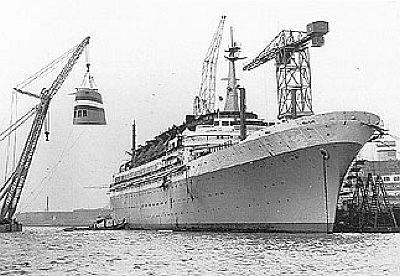
The
unnamed ship is seen here at her fitting out berth being completed, as her
funnel is being placed on board
On November 17, 1956, the ships very first
master, Captain Cornelis
Haagmans
boarded her at Schiedam
to supervise the concluding stages of her construction and fitting out process.
It was customary for Captain Haagmans to get familiar with his new ship as soon
as possible for his responsibilities also included taking out on her several
deep sea trials. The first of these was to test her engines and it commenced on
December 15, 1956. However, this trail went very badly as her engines suffered
an embarrassing total breakdown and five tugs had to be called on to tow her
back to Schiedam
returning onthe 17th. There was grave disappointment amongst all of the workers
at the shipyard and the Holland America employees who were on board the ship
and it mush have been demoralising for them, but they pulled up their socks and
continued and started to fix the problems at hand!
The engine problems were soon dealt with, but,
some of these mechanical flaws would occasionally come to the surface again
throughout her career. In particular her boilers would cause various problems,
but ten again, which ship did not have similar problem? But the 753 was given a
new kind of untried and an experimental type of boiler. After a month of
repairs she was ready for her trail, being her technical trial. This time she
had some 476 people on board, she departed Schiedam
at 0900 on January 14, 1957. This time, she performed extremely well. The
Captain even decided to push her and tried her out to top speed and she reached
an admirable 21.9 knots. After her excellent performance she returned to her
builders berth, arriving in the morning of January 17th.
Then on January 19, 1957, she departed her
builder’s yards and headed for her home port
of Rotterdam,
which is just a short two-hour voyage. However having arrived she was made
ready for an overnight voyage on the 23rd.on
the North Sea with some 500 special guests, one of the guests was the 18
year-old Dutch Crown Princess Beatrix (today she is HRH Queen Beatrix of The
Netherlands) and she officially named and Christened the ship in the restaurant. Her Highness was invited to pour
a glass of champagne over the ship’s 300lb bell and then she gave the
ship her blessing and the official name “I name her Statendam.” Finally she had a
name and an identity, which had not been known to the Dutch to date. The newly named SS
Statendam
arrived home in Rotterdam
the following morning and she was made ready for her maiden voyage early in May.
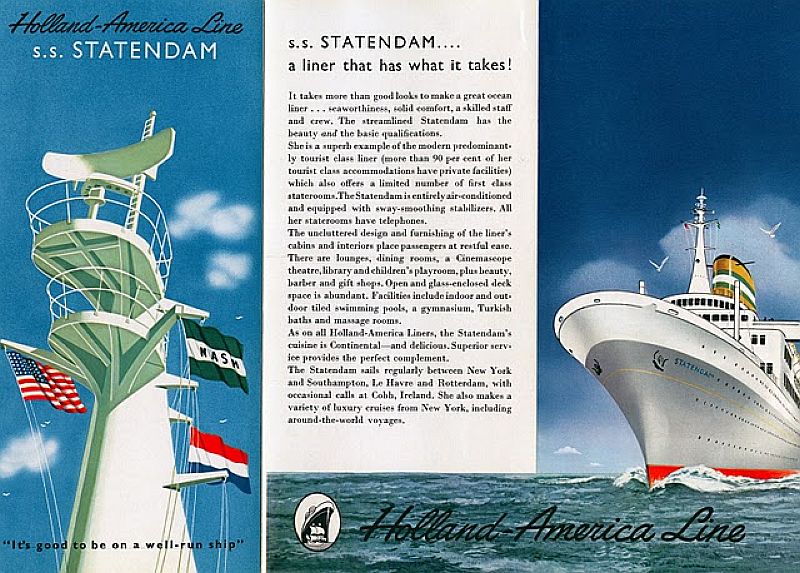
This
special brochure was a special pre-release in readiness for her maiden voyage
to New York
Her Externals:
Externally
SS
Statendam
was a ship that had perfect proportions in every respect. She had one of the
most beautiful and superb bow sections of her time and a beautifully rounded
stern. In between these were her long sleek lines and a beautifully styled
funnel and shapely mast atop her Observation Lounge. She was not overburdened
with cargo handling gear like so many liners of the day, as there was just four
unobtrusive kingposts, two forward two aft. She was soon rightfully considered
one of the most stylish liners of the day. Needless to say, the lovely classic Holland
America
Line dove grey hull with that traditional buff funnel with the company colours
emblazoned on it certainly did add to her charm!
Her Internals:
Internally,
the new and imaginative liner SS
Statendam
was designed to be a huge success for obviously “The Economy Twins”
the SS
Ryndam,
Maasdam had set precedence, and both had the vast majority of the ship designed
to be almost a Tourist Class liner with a very small First Class section. This
time the larger and more glamorous Statendam offered accommodations for 867
Tourist Class passengers, and 84 people in First Class, however these was to
comply with the “two-class requirements of the Trans-Atlantic Passenger
Steamship Conference” of the time.
In this respect the Statendam was very much
alike her two smaller fleet mates, but she offered a great deal more in terms
of luxury and comforts. Due to her being built as a passenger liner, unlike her
predecessors, she offered private facilities for 90% of her Tourist Class
cabins, as well as al her cabins being very much large. She featured an outdoor
pool and spacious outdoor deck spaces that made her a most suitable ship to
adapt for cruising duties during the off-season. However, she retained all the
traditional HAL features that Trans-Atlantic voyages were so famed for, such as
a long glass enclosed Promenade Deck, which was the absolute essential.
Cabins:
All
her First Class cabins were outside with windows accommodation from one or two
beds, with some having a third berth available, but every room, suite had a
private bathroom, telephone, which was rather new for the day, and the ship was
fully air-conditioned with controls in every room. Whilst Tourist Class offered
from one, two, three and four berth cabins, both outside and inside, with at
least 90% having a full bathroom, with either a bath or shower and like in
First Class all cabins had phone. The furnishings reflected the style of the
ship, contemporary, stylish with that traditional HAL touch of style. Those who
had sailed previously in Tourist Class on other ships would have though they
were being shown into a First Class cabin upon entering, for these rooms were
that good!
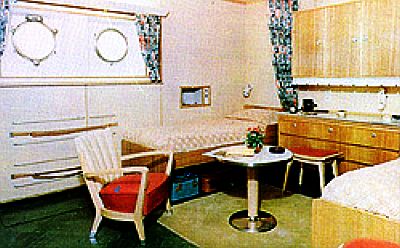
A
standard tourist class outside twin bedded cabin
Lounges
and Public Venues:
The
ships public venues were far from the old traditional
style and she followed the SS
Nieuw Amsterdam,
which was rather art deco, where the interior designers of the Statendam had
decided on a contemporary décor. However, they did continue that Holland
America Line tradition, by
using vast amounts of exotic woods in her public venues, such as bleached Ash,
Bubinga, and Rio Rosewood.
The Tourist Class Main Lounge featured a floor
area of some 5,380 square feet with seating for 450, being just over half of the
Tourist Class guest list. This fine room had a décor of soft warm colours such
as chairs and carpets warm yellow and old rose with a parquet dance floor in
front of the bandstand. Above there was indirect lighting that provided a
delightfully intimate atmosphere? Several of the walls in the Main Lounge were
adorned by multi-coloured ceramic depictions of the four seasons, which added
to the dramatic visual effect of this room. Amazingly, this theme, although a
much newer format and with a tulip touch was used on later HAL much newer
cruise ships.
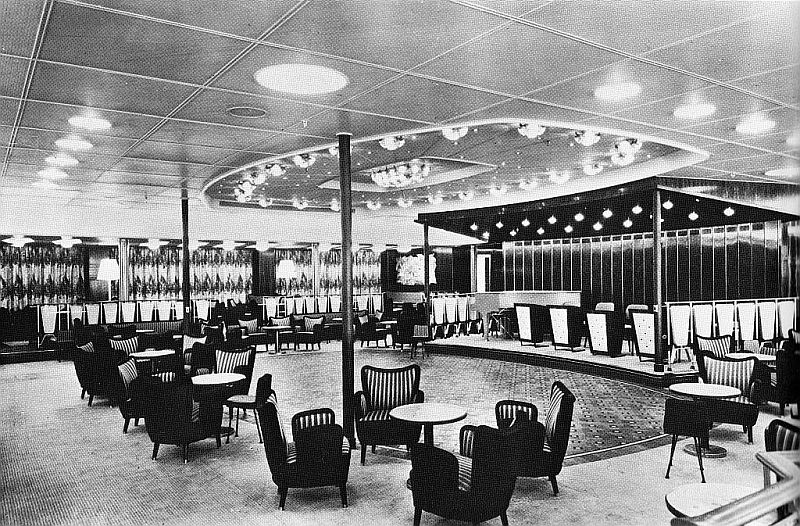
The
spacious Tourist Main Lounge and Ball Room
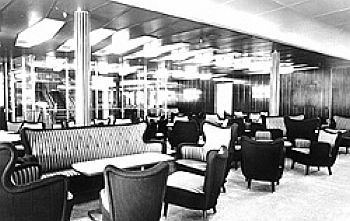
Here
we see another lounge view on board with a stairwell at the end
Just
forward of the Smoking Room there was the Ante Room that ran between venues and
this venue was adorned by a huge wall size tapestry that was named “By
the Well.” Panelling in this room was of Bubinga sourced from the African
Cameroons, whilst the chairs were in pale
blue half velour’s upholstery and the floor was covered by a hand tied
beige carpet.

The
Tourist Ante Room, looking toward the Smoking Room through the glass doors
Holland America
had also included a Palm Court
and Verandah on the Statendam,
just as they had done on many other previous liners. The secluded First Class
Verandah was done in a bright and cheerful fashion, with walls panelled in
cherry and a multi-coloured linoleum relief of the five continents. From here,
glass doors led to the Lido Deck and outdoor
pool.
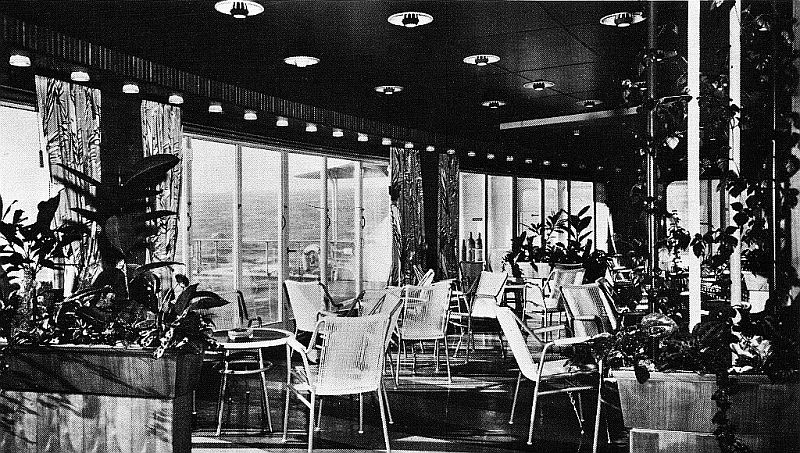
The
traditional Tourist Palm Court
(Veranda) overlooking the pool and aft deck
The
Ocean Bar, on the other hand, made use of black and grey for its floor and
ceiling, while accentuated by the lemon yellow, pale red, grey, and black on
the tables, chairs, and stools. And with the nature of the room in mind, the
designers had incorporated humorous line drawings on the walls and tabletops.
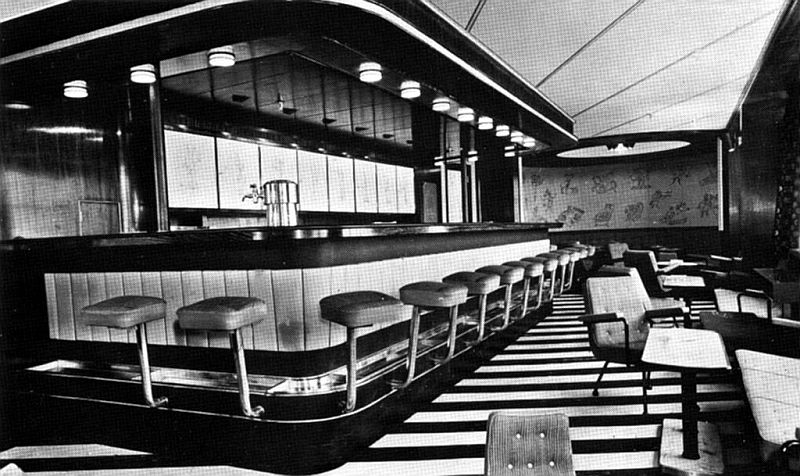
The delightful Tourist Ocean Bar
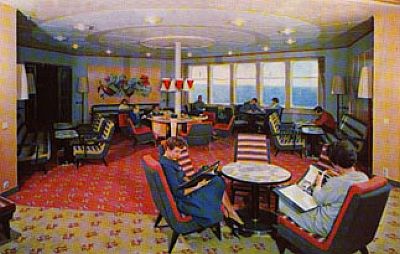
The First
Class Observation Lounge
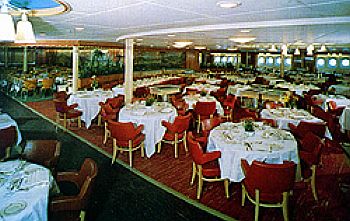
The
Tourist Class Dining Room
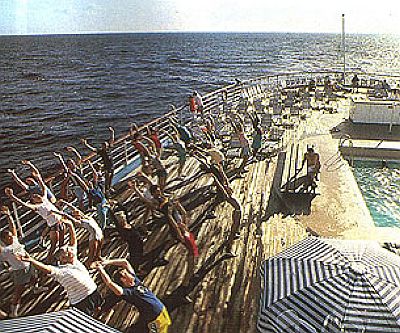
The
swimming Pool and spacious aft deck
Her Maiden Voyage:
SS Statendam
departed with some 877 passengers for her maiden voyage on February 6, 1957,
with Captain Haagmans’
standing proudly on her bridge as the ship sailed along the Maas
River
and headed for the North Sea bound for New York,
sailing via Le Havre and Southampton.
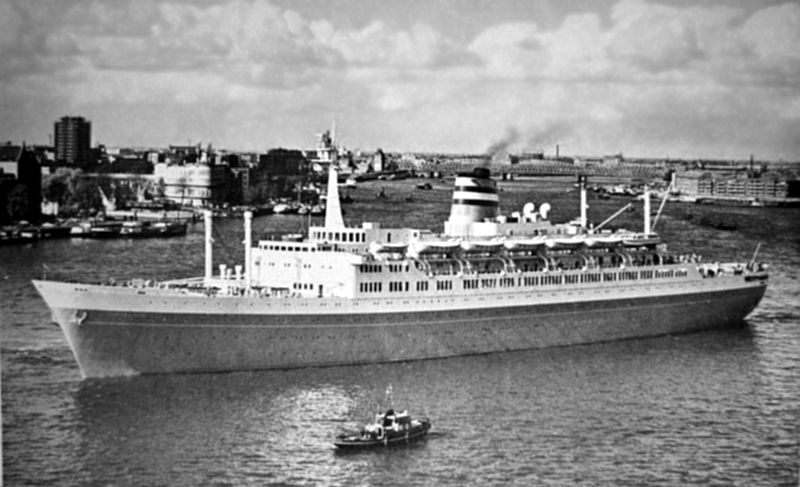
SS Statendam is seen departing her homeport Rotterdam
However, in spite of her luxurious and stylish
interiors the maiden voyage sadly was not greatly successful with all
passengers, mostly due to the ship encountering a severe storm and heavy seas
that led to a good number of cases of seasickness among her passengers. As it
was too dangerous for passengers to go out on deck, the entertainment staff
worked very hard to make the crossing as pleasant as possible by ensuring that
the entertainment was up to standard, well at least for those that were brave
enough to stay up and keep on going regardless no matter what! Soon they were
would be arriving into New York and as this was a new liner on her maiden
voyage, every one on board thought there would be a huge welcome awaiting thus
hem as they sailed up the harbour most were out on deck awaiting the spectacle
was the New York tradition. But sadly it was not to be on that day!
As the ship arrived in New York,
there was no big welcome and greeting, no festive a gala, close to nothing. The
reason for this was that there had been an ongoing strike amongst the harbour
tugs masters and pilots, thus it was not just her greeting escort was smaller
than expected for at least HAL did send someone out, the Captain discovered
that he would also have to dock the ship without the aid of any tugboats or
even with the assistance of a pilot. Although Captain Haagmans was to berth her
at the company’s Hoboken pier, a berth he knew well, but obviously to
date he did not have a great deal of un aided docking practice with this ship
and he could not possibly know precisely how she would behave without any tug
aid. Captain Haagmans
later admitted that the docking was no easy task, he later said: “I first
brought a headline ashore with our own lifeboat and dropped one of the anchors,
then I heaved her slowly alongside; not too slow to beat the incoming tide. At
7:10 a.m. it was all over and we were docked without any mishap.” Thus it
all went well and it proved his admirable skills as a great seaman!
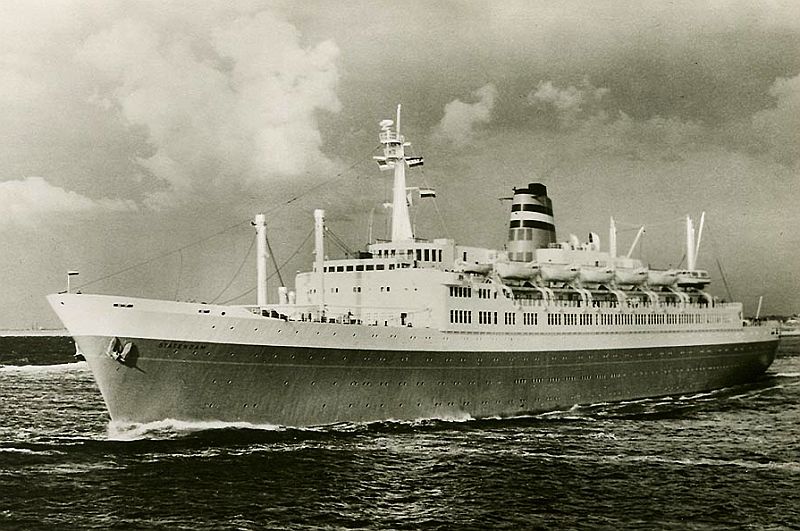
The
Statendam showing off her beautifully shaped bow for 1957
Following this eventful maiden voyage, the Statendam remained in New York
for a few days before she undertook three Caribbean
cruises. Prior to commencing to build her Holland America had already realised
that new ships had to be built for the dual purpose of transatlantic crossings
and cruise operations, and thus the SS Statendam
and the SS Rotterdam that would soon be built was no exception. On these
cruises, the Statendam would sail as a one-class ship, with a reduced passenger
capacity, thus giving her a superior passenger to crew ratio. She would
accommodate just 650 passengers on each cruise. SS
Statendam
returned to Rotterdam
on April 16, 1957.

She
is seen here during one off her cruises and showing her extensive aft decks
From
May though to December 1957, the Statendam
made ten Trans-Atlantic voyages, operating at full capacity on each occasion.
Following a further two cruises to the Caribbean, it was time for HAL to
summarise her first year duties and outcome was that the company directors were
extremely pleased with the results, considering that the Statendam had proved to be even more
popular and this meant financially so, than “The Economy Twins. She continued into
a regular Trans-Atlantic service combined with her regular cruise services,
which seemed to gain more and more popularity and it was due to her popularity
as a cruise ship Holland America
made one very brave decision and place her on what would become on an amazing
voyage commencing from New York!
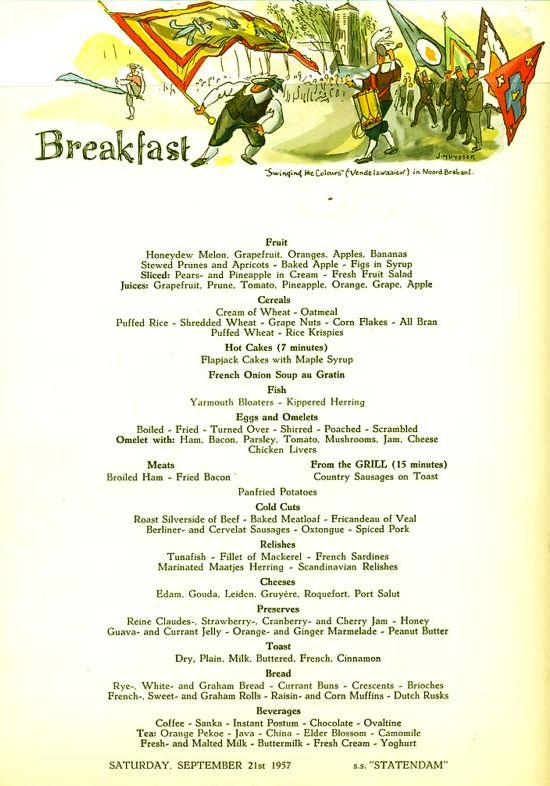
A
Tourist Class Breakfast menu dated September 21, 1957
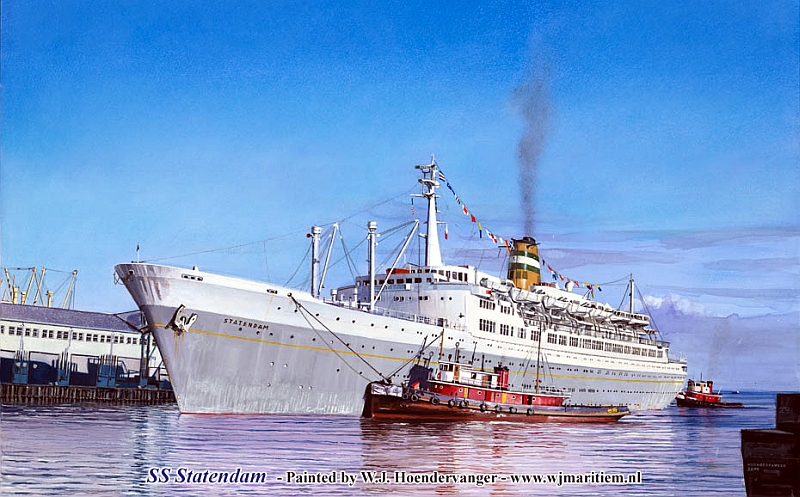
A
superb painting of the SS Statendam by the
superb Dutch Maritime Artist Mr Hoendervanger
Visit
his site at: www.wjmaritiem.nl
SS Statendam departed New York
on January 7, 1958, and commenced on a 110-day around the world cruise, being Holland
America
Line’s very first ever. For this voyage two special motorboats had been
fitted on top of hatch two in order to assist shore with tendering whilst at
anchor. Also she had a crew of 503 with an additional cruise staff of 26,
whilst there were only 351 passengers. The reason for the low numbers was that
this voyage was meant to be an exclusive and luxury cruise. This crew/passenger
ratio that was almost 2 to 1 guaranteed the highest level of service and the
passengers got all that and so much more!
Her very first port of call was to be the Cape Verde
Islands,
but sadly there was an encounter with a violent east-south-easterly gale that
resulted in one of those extra motorboats being lost in the storm, and due to
the subsequent delay the ship was forced the ship to cancel her first port of
call. Thus, she headed for Dakar,
where she arrived on January 14. From there she continued to Freetown
and Pointe Noire, where yet another incident would occur when the Statendam was
departing. With the harbour pilot on board to take the ship out, the Captain
advised him clearly that the ship
had very good reverse power. However, he took no heed to his warning, the pilot
ordered the engines to “slow astern” instead of the recommended
“dead slow.” Considering that the Statendam was docked between two other ships, this manoeuvre
could have easily ended up in disaster. But thanks to a “miraculous
stroke of luck” as Captain Haagmans
later said, everything went well, although it was by a very small margin. The ships lines snapped, but
thankfully she did not run into the ship astern. The Statendam continued aft and passed the other ship along the
whole length just a few feet next to her thanks to some rapid thinking on the
Captains side at the steering wheel. The pilot decided that it was better to
let the Captain handle all the engine commands from here in, and then he could
safely bring the ship out of the port. With this dramatic event behind her, the
Statendam continued her
spectacular around the world cruise without any further hitches! She continued and
sailed via Luanda,
Walvisbay, Cape Town, Durban, Zanzibar, and Mombasa.
She then arrived at Bombay where
she remained for a full week to allow passengers to make a trip to Nepal.
Following her week in India,
SS
Statendam
sailed via Colombo (Sri Lanka),
Penang, Singapore
to offshore near Bangkok.
There a coastal vessel came alongside and took on passengers for transportation
up the river. As the rest of the cruise continued, she sailed to Bali, Manila, Hong Kong, Formosa,
Okinawa, and Yokohama
before proceeding across the Pacific Ocean to Honolulu, San Francisco,
and Acapulco.
She then passed through the Panama Canal and stopped at Cristobal before
heading back to New York,
returning April 26. Holland America Line’s premiere world cruise became
known as a splendid success and this would be a beginning of many more to
follow, by the Statendam as well as her newer fleet mate the “Grand
Dame” that would be completed in 1959, the superb SS Rotterdam V.
SS Statendam after three days in New York
returned to her regular North Atlantic trade and sailed back to Rotterdam,
where she received a quick clean up in dry dock and returned to service to
spend the summer season on the Atlantic Ocean.
In June
that year, Captain Haagmans
was transferred to the company flagship SS Nieuw Amsterdam for his last voyage as a Captain. But when he
retired at the age of 60 he boarded his favourite ship, the SS
Statendam,
the ship he called his friend, but this time he came on board as a passenger
and sailed to New York.
Later he recalled that it was “a very special and emotional voyage”
for him.
The changing times:
Captain
D. Van Dalen, took command of the Statendam
and she continued her career both as a liner and a cruise ship, spending
nine months on the Trans-North Atlantic service and then she operated another
world cruise in 1959, This would was the ships second such grand voyage, but
also for the Holland America Lines second ever. Although the company’s
shorter cruises around the Caribbean had become very popular, these voyages
were provided the signs what the future had in store for all of the
Trans-Atlantic ocean liners, for it was becoming obvious that passenger traffic
on the Atlantic
was rapidly declining!
As the 1960s continues, it was becoming more
and more obvious that more passengers were travelling by air instead of opting
for the slower route by sea, and therefore many countries with liners that
served the North Atlantic decided to lessen services or simply discontinue them
and sell their ships altogether. As a result, many liners were rescheduled to
operate on more pleasure cruises and the already popular SS
Statendam
was certainly no exception. Slowly her time crossing the Atlantic
became less and less every year until 1966 when it was decided that she would
become a full-time cruise ship. The two-class system was totally abandoned, and
her load capacity was reduced to just 650 passengers.
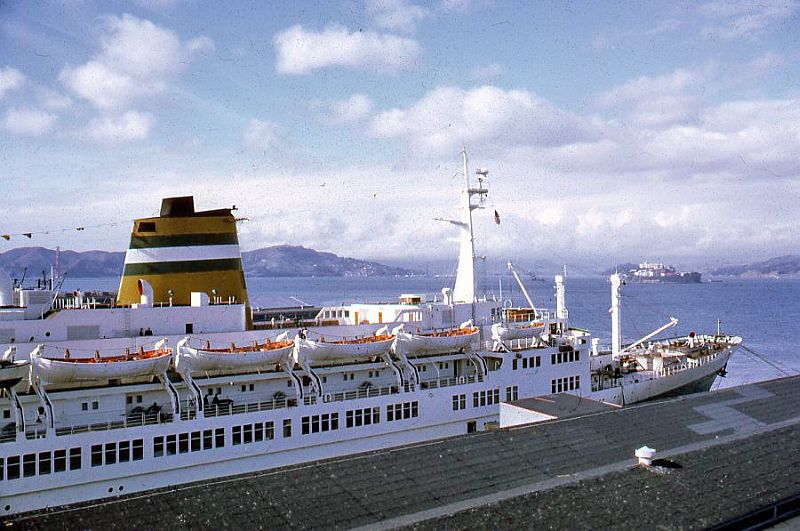
Here
we see the Statendam berthed in San Francisco,
Alcatraz
can be seen on the right
Photographer
unknown – *Please see Photo notes at bottom of page
In
October 1965 she departed New York
and sailed through the Panama Canal and several West Coast
Cities,
including San Francisco,
voyaged via various Pacific
Islands
and called to Auckland New
Zealand
and Sydney
Australia
for the first time ever. Although this was certainly nor HAL’s first
visits to Australia for the SS Ryndam had arrived in 1964 and the SS Maasdam in
1965, but certainly not as luxury cruise ships but operating as migrant ships
into Australia and tourist ships homeward. The Statendam returned to the USA
sailing via Asia. She
operated the same voyage in 1966 and again in 1967.
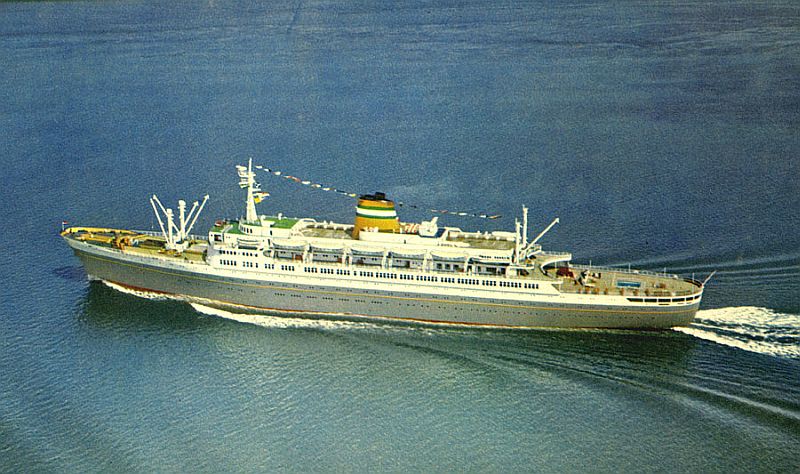
A
fine areal photo showing off her extensive deck space and her aft open-air pool
Her
1967 visit to Sydney
was going to be very special indeed as it would the very first time ever that
two Holland America
Line passenger ships were in the Port
of Sydney
at the very same time so far from home. Thus, on November 7, 1967 both the SS Maasdam
had sailed direct from the Netherlands
via the UK,
and SS
Statendam
on her cruise, were in Sydney
proudly showing off their spotless livery of grey hulls, gleaming white
superstructure, their proud buff funnels with those green and white HAL bands
on them. Such an event would not happen again, well not until the 21st.century when two HAL cruise ships are stationed
in Sydney, being the ms Volendam and ms Zaandam in 2011/12 and in 2012/13 the
ms Volendam and ms Oosterdam, in addition with regular visits of the ms
Amsterdam and the ms Rotterdam VI.
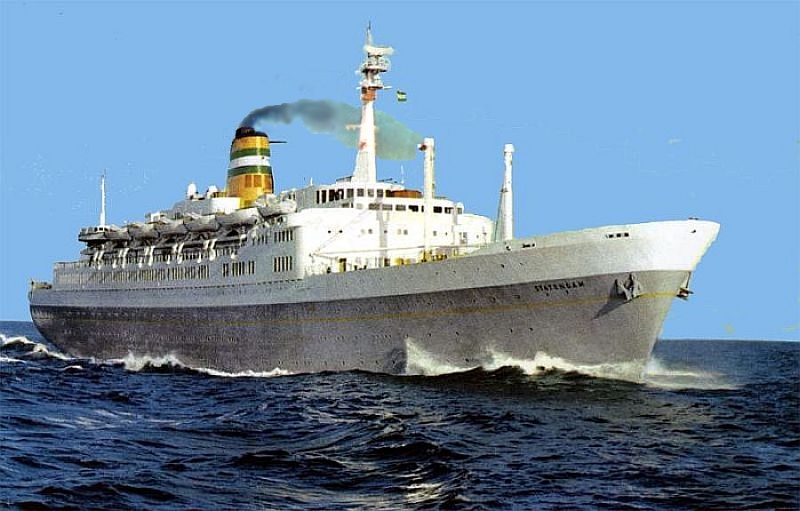
Another
fine HAL SS Statendam postcard heading for New York
at full speed ahead!
After
the Statendam visit in 1967 it would be another five years before she would
return to New Zealand
and Australia,
but she would be a very different ship to the one that had been seen Down Under!
The all-New SS Statendam:
Holland
America Line saw great potential in the Pacific Ocean, and
they started operating the Statendam
from the American west coast. Already she made a series of luxurious cruises to
the South Seas, New Zealand,
Australia,
and the Orient. She proved to be so popular that frequently guests on board
would include a good number of movie stars and famous people and VIPs on
vacation. Thus HAL’s cruise ventures proved to be extremely successful.
In 1971 the company had already decided on a
new company flag and logo as well as an updated fleet livery, more suitable for
cruising as this had become their major source of income. Also, HAL decided to
evolve and when the opportunity came along the company purchased one million
shares of “Westours Inc” and they acquired 85% of their shares in
February 1971. Westours had been a major force touring to Alaska and Yukon
as of 1947, and this tradition would now be continued by Holland America Line.
Thus they decided to restructure their outlook as well as their fleet’s
livery. All ships would be repainted with a royal blue hull and red boot
topping, topped with a gleaming white superstructure. The ships funnel would
now be orange, which is the traditional “House of Orange” colours,
being the Royal Family as well as the country’s colours, adorned with
three stylised lines, “aqua, white, and aqua.”

The
Statendam entered the Rotterdam Dry-Dock Company in September 1971, where she
was given an extensive internal rebuild and refit in and externally. This would
see her original Sports deck completely taken up with a brand new superstructure
from fore to aft, and her Promenade Deck would be completely be rebuilt, with
little to nothing of the original fittings remaining, which was rather sad! Due
to entering a new market, there would be a Casino, larger lounges and aft deck
have windows extended as a windshield for her pool areas, as well as showers
added at the rear of the pool.
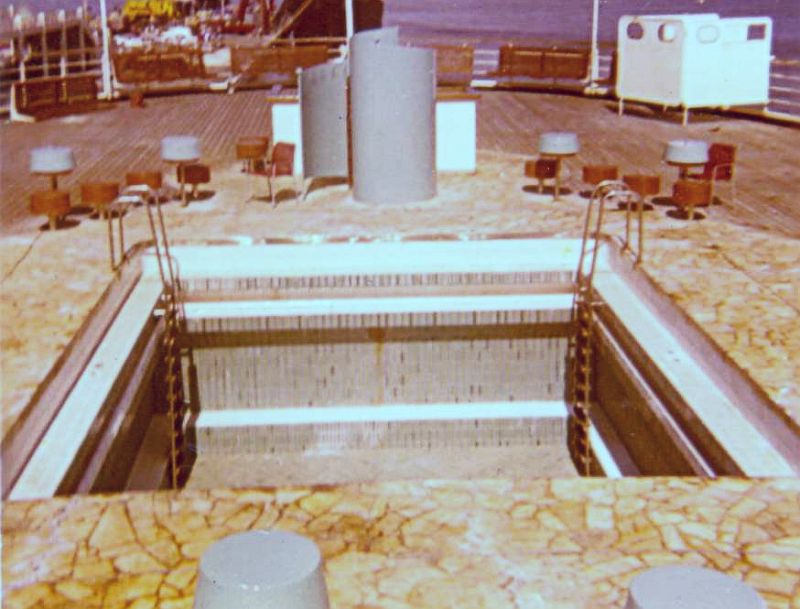
The
new Lido and pool deck
with its showers and lighting systems installed
Photographer
unknown – Please see Photo notes at bottom of page
But
the saddest of all for so many was that the enclosed promenade areas had now
gone for these spaces had made room for the new larger public rooms. She was
also given an enhanced lido and pool deck aft, with new windows along the sides
as a windbreak and showers aft of the pool and other additional facilities! All
her accommodations received a massive upgrade to the very highest of standards
and when completed she could accommodate 740 passengers. In all, after five
months of work and at a cost of US$7 million, she was like a brand new ship.

The
new look for the SS
Statendam
was not just internally but she had also big changes internally!
Photograph
by Victor
Scrivens – from
the Rich
Turnwald
collection
Upon
completion, the SS
Statendam
recommenced her sailings on March 14, 1972, as she
returned to New York from where
she made Caribbean cruises as
well as extended voyages like the one later in the year. The Statendam departed
the United States
for her fourth and final visit Down Under and she arrived in Sydney
on November 19, 1972 and her passengers enjoyed an overnight stay departing on
the 20th. She returned to the USA
via Asia. Sadly Australia
was not to see her again. In 1973 she was reregistered to Holland
America Cruises in Willemstad
Curacao and all HAL ships would now employ
Indonesian service staff rather than just all Dutch.
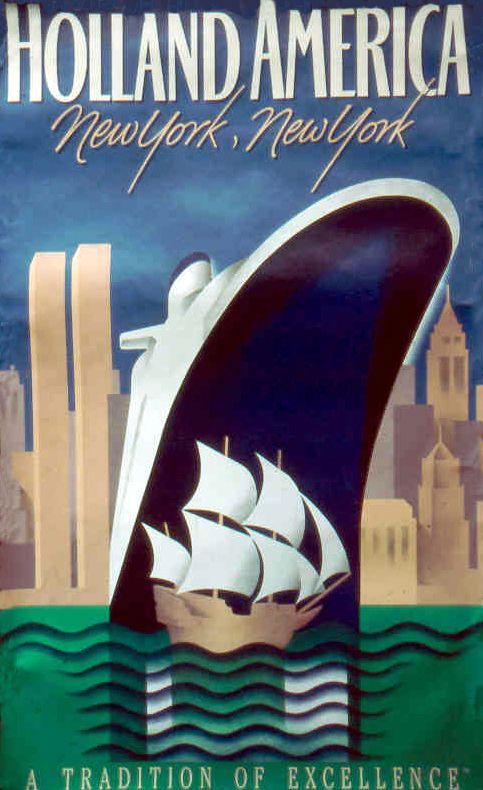

A
Holland America Cruises SS Statendam souvenir teaspoon
Statendam continued cruising the Caribbean and Bermuda until 1981, except for
1979 when she was selected together with the SS Rotterdam to represent Holland America
Cruises at the New York
Harbour Festival. After
which she returned to her cruise duties. Then in 1981 she was relocated to Vancouver
to operate 7-day Alaskan cruise during in summer, which proved to be rather
successful and it became a lucrative market for HAL and just about every other
cruise line these days!
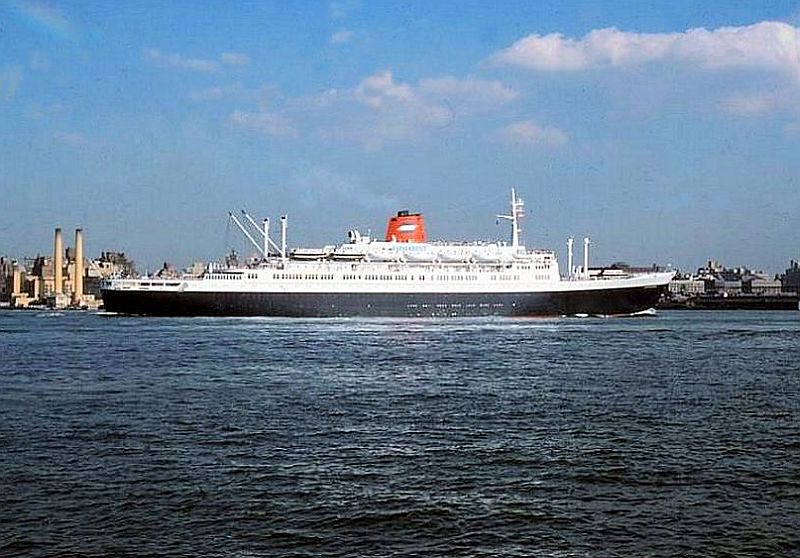
SS Statendam seen berthed
Photographer
unknown – Please see *Photo notes at bottom of page
Statendam’s
final HAL days:
However,
at 27 years of age, it seemed that the Statendam
was no longer in the best of condition, which was mostly due to her boiler
problems, which had always been a source of worry every now and then. But the
time had come they were really becoming a problem. It came to the point she was
having ongoing breakdowns causing disruptions to her schedule even requiring
costly repairs. In several ports the authorities placed a notice on her due to
engines producing foul emissions.
Then the worst incident of all came about, for
whilst she was off Antigua in 1982, her
generators failed completely and this resulted in total power loss throughout
the ship. As all lights and air-conditioning went out, the ship drifted for
many hours before the electricity could be restored. But it had been decided at
Head Office that situation was no longer acceptable, and although HAL had
already decided earlier to sell the ship it was now time to release her.
Going French - the SS Rhapsody:
The
once elegant and ever popular SS
Statendam
was officially handed over to Actus Investments Ltd, in October 1982 and placed
under the management of the French company Paquet Cruises. She received repairs
and a refurbishment and a new livery, being all white including her funnel with
a large stylised P with the top part in aqua with a flying
seagull and the bottom in red. Her hull also had an aqua ribbon surrounding her
hull. Upon completion she was renamed Rhapsody and reregistered in Panama
and given a multi national crew.
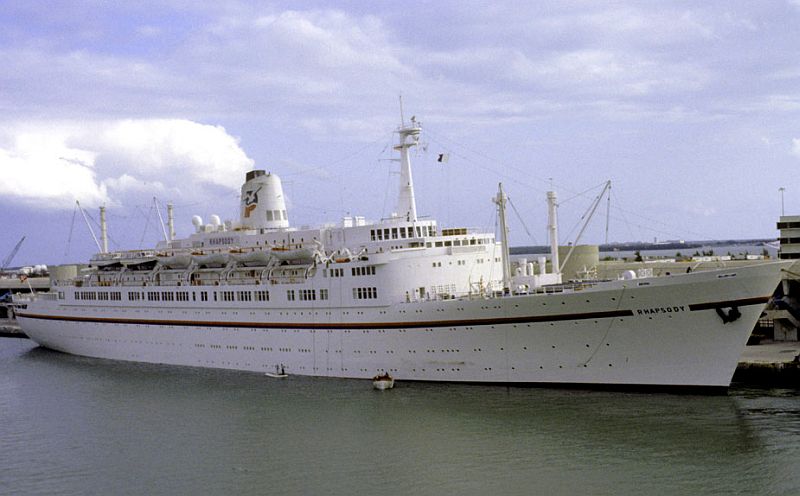
SS
Rhapsody 1983
She
returned back to operate Alaska cruises in the
summer and Caribbean service in
the winter, much as she had done before. However, soon enough her new owners,
began to realise that their new ship was not all they had hoped for, as
mechanical problems continued to plague her, and due to this the company was
certainly not being very profitable, to say the least!
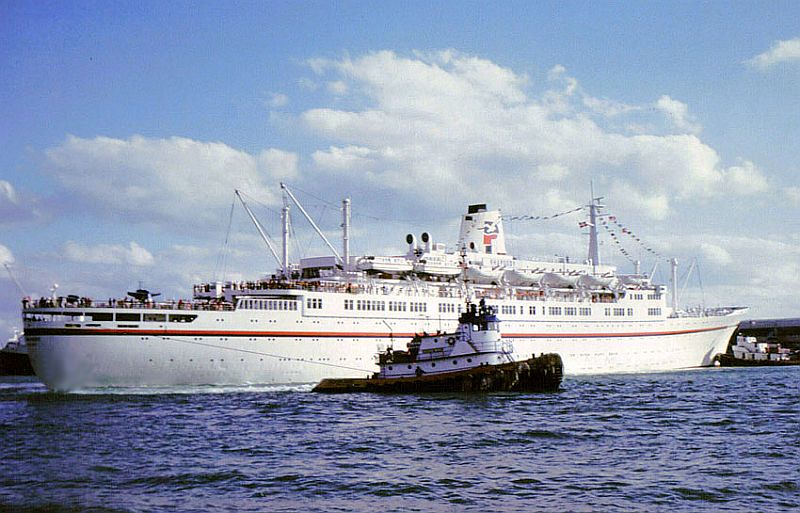
Rhapsody
Stern
But
far worse was still to come, and no one can blame her engines for this, for on
March 28, 1984, the Rhapsody
suddenly struck some rocks and was firmly stuck on them at the Grand Cayman,
near Georgetown.
After three days sitting there with nothing happening passengers were very
angry, and they were finally taken off the ship and flown home on the 31st. The
Rhapsody remained there for
over two months before she was refloated, which finally happened on June 15.
She towed to Galveston
where she would have to undergo the required repairs. Then in September she
returned to her cruise duties from Port Everglades,
but she was a failure and never a profitable ship for Paquet Cruises, the whole
affair had been a total failure. Paquet placed her on the market and prayed
that there would be a buyer for this, what now seemed to be a plagued ship!
MS Regent Star:
She
was sold for US$12 million to Universal Glow Ltd, Piraeus,
part of the Lelakis Group, on March 11, 1986. This company was owned by the
well-known Greek businessman Antonis
Lelakis,
who renamed her Regent Star.
She was intended to be one of his new cruise company’s first ships, for
Lelakis’ had recently founded Regency Cruises. She had been handed over
on May 4 at Port Everglades and she headed for Piraeus,
Greece,
where she was given, yet another extensive refit. As Mr. Lelakis was well aware
of the engine problems, he had obtained a container ship the MS Margaret
Johnson in February 1986 that was going to be rebuilt as a cruise ship, but,
now with the arrival of the SS Regent Star, it was better to use the diesels
engines of that ship and place them into the ex Statendam and removed her old
troublesome steam turbines. The Margaret
Johnson
was then sold for scrap.
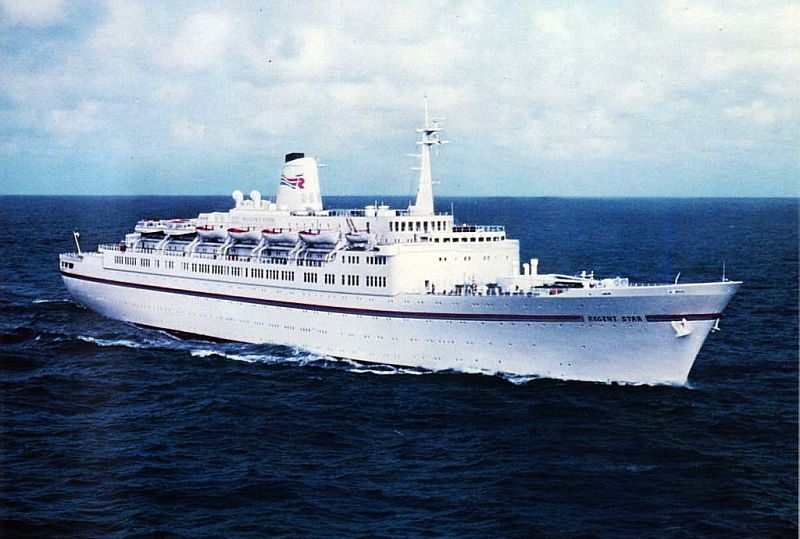
A
postcard of the MS Regent Star
Her
passenger capacity was now 950, which meant an additional 75 new cabins had
been installed. With her refurbishment completed, the all-new MS Regent Star entered service for
Regency Cruises on July 26, 1987, commencing cruises from Montego Bay,
Jamaica.
After which her programme seemed much the same as that she has followed most of
her cruising life on the West and East Coast of the USA,
from Vancouver she
operated summer Alaska cruises and
the rest of the year Caribbean cruises.
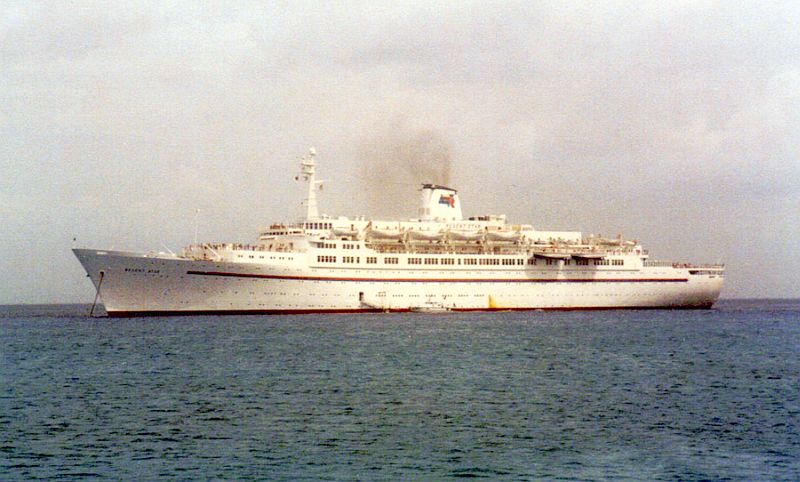
MS
Regent Star seen in 1990
Photographer
unknown – Please see Photo notes at bottom of page
However,
in June 1990, she returned to New York
for the first ever-Regency Cruise operations from this port. Sadly it would be
on Memorial Day 1990, that she again had a problem as she ran aground some 25
miles up the Delaware River.
However, the Delaware
ferry came to her assistance very rapidly and manoeuvred alongside her port
side and unloaded all passengers that were onboard. Thereafter, the Regent Star
was then able to get off and thankfully she was practically undamaged.
But after a while the Regent Sun replaced her on the company’s New York-Eastern
Canada service after only a year. Regent Star was returned to Alaska
to her old service there. She continued her normal duties until the summer of
1995, when the ship once again became the scene of yet another dramatic event.
Whilst she was approximately 65 miles
southwest of Valdez,
Alaska,
there was a ruptured fuel line, and this resulted in a fire in the engine room
that crippled the ship. The Captain ordered radio calls to be sent out and
amazingly, the very first ship to arrive assist her was her long time running
mate, the SS Rotterdam. She
immediately assisted with the unloading of all her passengers.
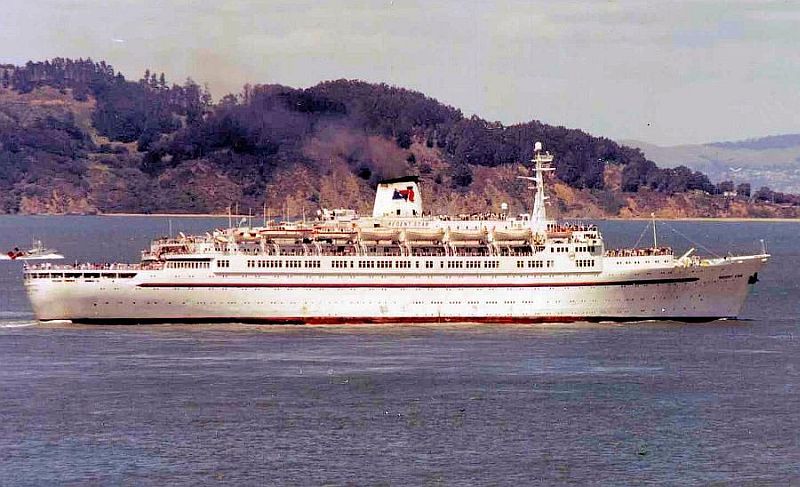
Regent
Star seen during her final days in 1995
Photographer
unknown – Please see Photo notes at bottom of page
But
tragically in October of 1995, Regency Cruises collapsed and their fleet was
scattered at sea or in various ports. Regent
Star was at the time voyaging a part of the Panama Canal, whilst on a
cruise of the Caribbean, Florida and
eventually heading for the Mediterranean. But as
had been known by some, the company had been in financial difficulties for some
time, and crewmembers on board the Regent
Star had been waiting for their salaries that were slow in being paid.
In addition, the ship was having shortages of supplies and stores, but when the
final announcement regarding the collapse came, the ship concluded her cruise
and her captain headed away from the awaiting American creditors at the next
port and headed for the Mediterranean.
Her last days as the MS Sea Harmony – Harmony I:
When she
arrived in Greece
she was arrested and taken over by CIT Financiers of New
York and
she was placed at anchor at Eleusis Bay
Greece
in November 1995. In 1996 she was sold to Perosea
Shipping Co and was renamed Sea Harmony and it was intended to return her to cruise
duties, but she remained in laid-up. She was returned to the open market, but there was no real interest.
Although there was the occasional weird ideas to purchase her, one was by a
company named CruiseShares, who thought to introduce a timeshare-style system
on board and operate her with a small fleet of other older refitted cruise
ships. However, the whole idea was soon abandoned, as for that time there was
little to no chance at all of it taking off.
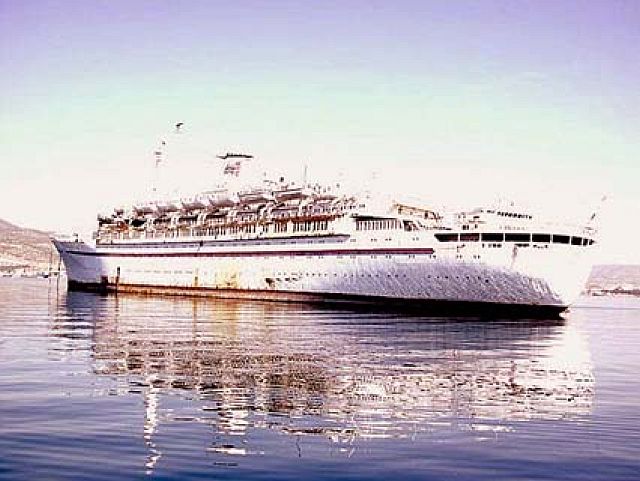
The
Sea Harmony is seen here in July of 2003
Photograph
was taken by my dear friend, the late Captain Yiorgos (George) Graikos
The
once glamorous and revolutionary ex SS Statendam sadly
remained in Greek waters and thus this great once Trans-Atlantic liner and very
popular Cruise Ship commenced, due to her being neglected with no maintenance
done on board whatsoever, she rapidly deteriorated she slowly became a rusting
hulk and she became a sad looking ship at anchor in the middle of Eleusis Bay and she began slowly listing slightly to starboard.
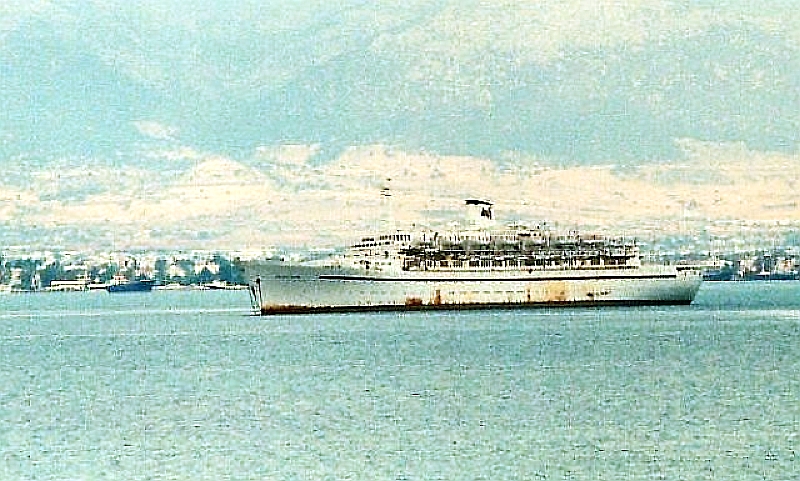
The Sea
Harmony is seen during her very last weeks at Eleusis Bay Greece
looking rusty and listing to starboard
She has
been sold and headed for the breakers yard in India
After a long lay-up for 8 years and 9 months,
on March 14, 2004 this proud liner, looking very shabby and to say at least rather
old due to her rusty and weather beaten hull, she finally departed Eleusis Bay
with a new name painted on her bow “Harmony I,” and flying the
traditional flag of death for ships that are bound to the breakers yard, and
that id the dreaded “St Vincent and Grenadines” flag for her
delivery voyage to Alang beach in India.
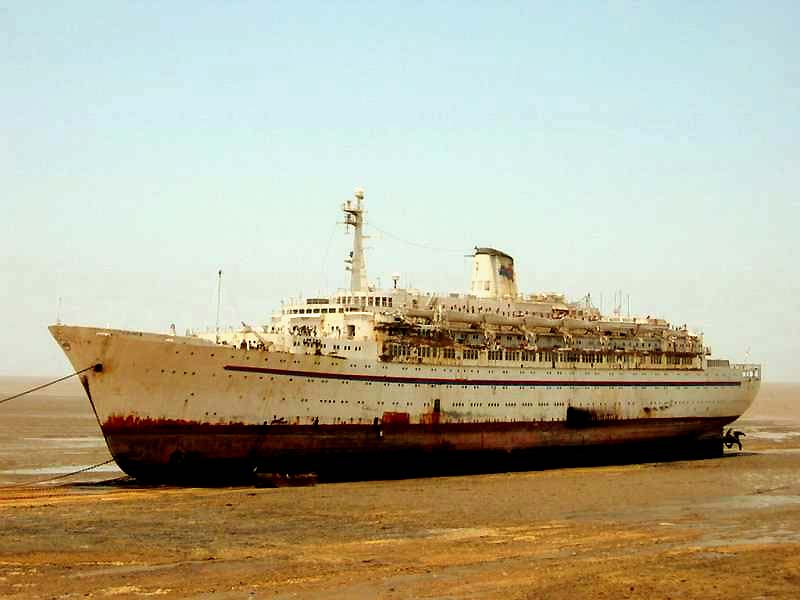
SS Harmony
I is seen after having bee beached at Alang
This
photograph was sent in by a supporter, thus source & photographer is
unknown – Please see photo notes at the bottom of the page
Above we see a tragic sight of
the now renamed MS Harmony 1, ex Sea Harmony, Regent Star, Rhapsody built as
the elegant Holland America
Line SS Statendam
seen beached at Alang India,
awaiting the hordes of workers
with their cutting tools to
come aboard and commence cutting her up into pieces, although her interiors had
already been stripped.
Not long after her
arrival work on dismantling commenced. Perhaps this was the most dignified end
to a long and glorious career of the SS
Statendam
with Holland America
Line. For her final years with the other companies were far from her finest
days!
Memories
of the Wonderful Holland
America
Line S.S. Statendam
This
is the way ship lovers and past passengers prefer to remember
this fine and revolutionary liner/cruise ship
the much loved … SS Statendam
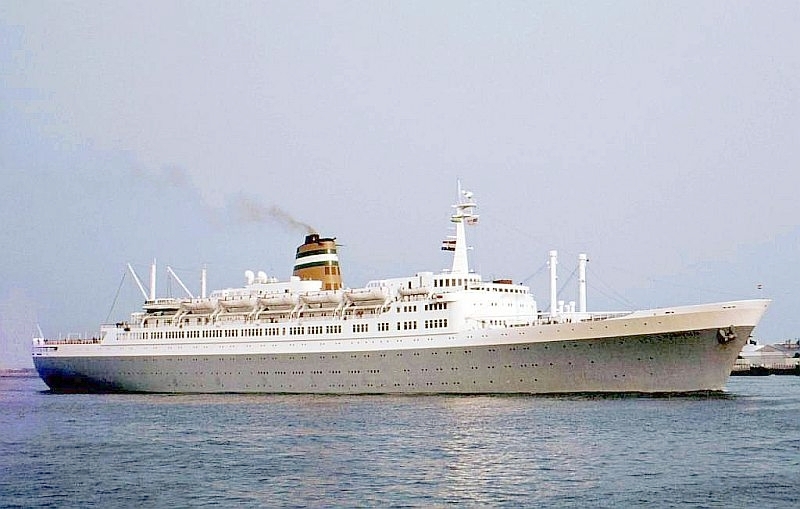
She
looked wonderful in her original colours and many preferred it far more than
later with her
blue hull and orange funnel livery
during her cruising days! But it is
all a matter of choice!
SS Statendam specifications:
Built
by: Wilton
Fijenoord Schiedam.
Yard: 753.
LR/IMO
No: 5339212.
Tonnage: 24,294 GRT – call sign
PDPT
Length: 642ft / 196.2m.
Width: 81ft
/ 24.7m.
Draught: 25.91ft
/ 7.9m.
Engines: Parsons four steam geared
turbines.
Screws: Two - 22,000 BHP.
Service
speed: 19 knots
Passengers: 84 First Class
& 867 Tourist Class
Crew: 474.
In
Conclusion - summing up the SS Statendam:
In
1957, when Holland America Line's SS Statendam debuted and she became an
instant hit on North Atlantic crossings from Rotterdam to New York as well as
during her seasonal cruising programs. As the Statendam was built to be mostly
as a Tourist Class ship, but one of the major factors to her great success was
the high quality of her accommodation, which was in reality very close to first
class standards of most ships operating at the time as were her superb public
venues, which occupied the full length of the ship, whereas on most ships,
Tourist is located aft. Thus, for a predominantly Tourist Class liner she was
miles ahead of all the competition and she was a vast improved version of the
two pioneering ships I have already mentioned being the much loved
“Economy Twins” - SS Ryndam and Maasdam, which preceded her.
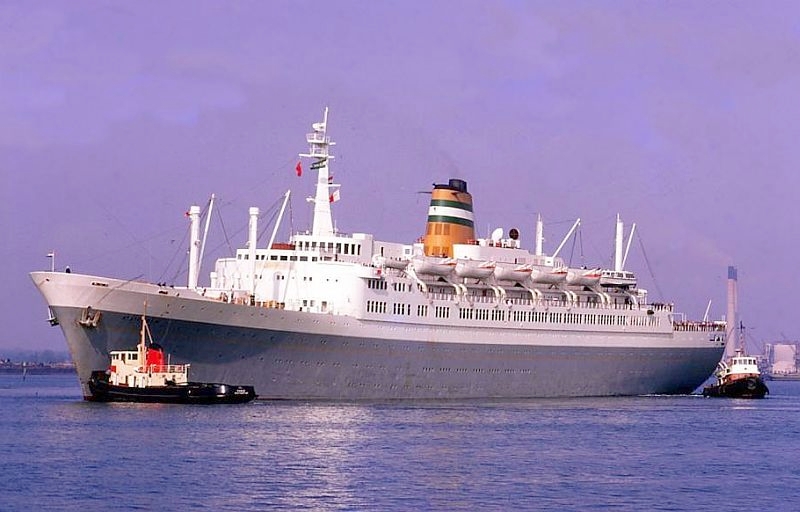
Here
we see the SS Statendam in her
glory days departing Southampton
for New York
Photograph
sent in by David
Franks – taken by
“J.K. Byass”
SS Statendam was later rebuilt as a superb luxury one-class permanent cruise
ship in 1972. The transformation was so vast that Holland
America
Line dubbed her to be "The Cinderella Ship" in their publicity
material. Sadly, little of her original decor survived this refit,
which saw a complete rebuilding of her Promenade Deck. However, in
certain parts of the ship, various traces of her 1950s traditional
elegance did remain. One of the main remnants was the indoor pool, the
cinema, and the purser's lobby.
Ten years later in 1982, the Statendam was
sold to the French company Paquet Cruises, who gave her a refit and renamed
her Rhapsody. She proved successful, hut they obtained a much newer ship
that would prove more economical to operate, thus in 1986, she was sold to
Regency Cruise Line who renamed her Regent Star.
Although both companies made changes
internally, but they did leave a number of the original parts of the ship in
tact. The Regent Star sailed on until 1995 when she was placed under arrest in Greece
and taken over by CIT Financiers of New York, and she was laid up. As a
very neglected sad and a rusty looking ship, she remained at anchor at Eleusis,
Greece under the name of Sea Harmony until being sold to Indian breakers as the
Harmony I in 2004.
**************************************************
ms Statendam V – 1993:
The
fifth ship to carry the famed name Statendam would enter service in 1993 and
she is at the time of writing one of 15 Holland America ships operating around
the globe that continue the rich and elegant traditions of Holland America
Line. This famed company commenced operations in July 1872 has now won more
“The Highest Rated Cruise Company” from “Conde Nast”
and the “Best Overall Cruise Value” 20 for consecutive years, and
they continue to keep winning these awards right until this year in 2013, even
in Australia, the “Australian Federation of Travel Agents” (AFTA)
has awarded HAL the title of being “Best
Cruise Operator.” From the 1950s to this very day, Holland
America
Line is still known as having “The Spotless Fleet” which is a great
compliment.
The author has sailed with Holland America,
the last cruise being on the delightful 61,214-ton ms Volendam
accommodating just 1,430 passengers, unlike most ships of this size having
around 2,000, and I can tell you that this ships was supreme and sailing with
HAL is simply one of the finest cruise you can possibly experience at sea, for
there is not one other company that I can name that is better!
The crew to passenger ration is excellent as is the excellent service, supreme
cuisine and some of the best entertainment. I found that HAL does not push that
typical oceangoing trashy over the top Las Vegas style entertainment on their
passengers as seen on most ships, for the production shows and guests
vocalists, orchestras, classical concerts were all sublime!
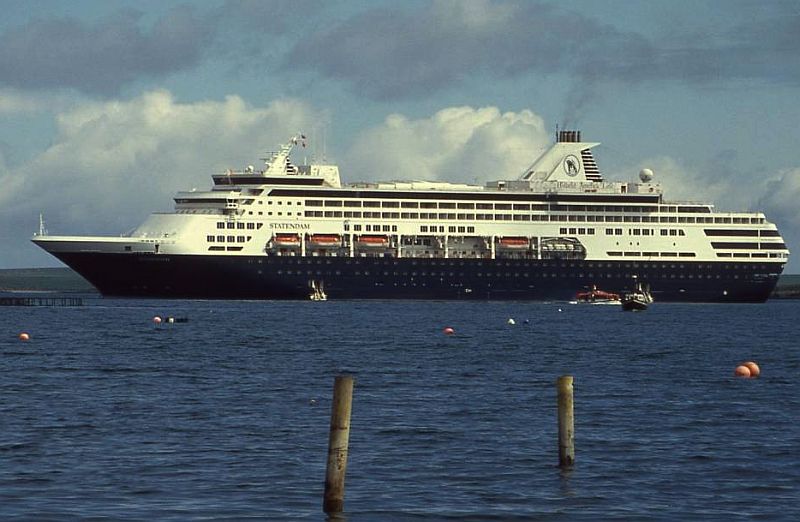
The
MS Statendam V
PS: The ms Maasdam
and her sister the Ryndam were transferred to P&O Cruises Australia and
were given an amazing internal refit. They were renamed the Pacific Eden and
Pacific Aria respectively, with the Eden being based in southern and western
ports of Australia, whilst the Pacific Aria, being home ported in Brisbane
where she became the most popular and
Highest rated P&O ship, whilst the Eden somehow never did as well, yet they
were identical.
With new
ships up to 114,000 gross tons entering the P&O Australian fleet, the
Pacific Eden will depart Australia on March 16, 2019 as she will be transferred
to the UK “Cruise and Maritime Voyages” (CMV) early April 2019.
Thus the ex Statendam V
will continue to live on providing British passengers much joy at sea!
You can read about other Holland America
Line Ships on ssMaritime.com
SS Nieuw
Amsterdam -
SS
Rotterdam V - SS Volendam (ex SS Brazil)
TSS Ryndam &
Maasdam - SS
Diemerdyk & Dinteldyk
-Also
visit my other Holland America
Pages-
Page
One …
“The
History of Holland America Line and Today’s Modern Fleet”
1872
to 2000
Page Two
… “The History of Holland America Line and Today’s Modern Fleet”
1993
to 2015
-Holland America
Line Ships featured on Cruise-Australia-
ms Rotterdam - ms Volendam - ms Zaandam - ms Oosterdam & ms Nieuw Amsterdam
-Cruise
and Ship Reviews by the Author-
ms Oosterdam 2013 Cruise’n’Ship Review
ms Volendam Cruise Review - ms Amsterdam Ship Review
**************************
Use the Back button on your browser or
Close the Page to return to the previous page
or go to our INDEX
ssMaritime.com & ssMaritime.net
Where you will discover over 1,250 Classic Liners & the 1914 built MV
Doulos Feature
Photographs
on ssmaritime.com, & .net and associate sites are by: 1. By the author. 2. From
the author’s private collection. 3. Or as provided by Shipping Companies
and their Publicity Companies as well as by private photographers or collectors.
Credit is given to all contributors. However, there are some photographs
provided without details regarding the photographer concerned., therefore I
hereby invite if owners of those images to be so kind and make them-selves
known to me per email at rg@ssmaritime.com in order that due credit
may be given
ssMaritime is owned and © Copyright - Reuben
Goossens
- All Rights Reserved
